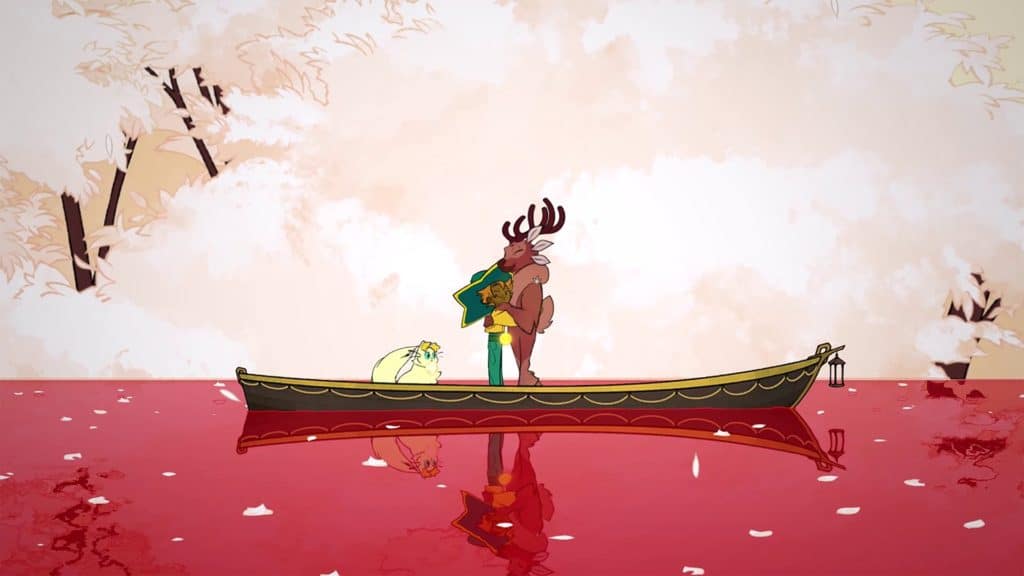Video Gamer is reader-supported. When you buy through links on our site, we may earn an affiliate commission. Prices subject to change. Learn more
Thunder Lotus Games describes Spiritfarer as a “cozy management game about dying.” At first glance, it may appear antithetical to plant the words “cozy” and “dying” close together. Yet, come to think of it, there is a certain coziness to death. When something is missing, other things rush to replace it, like digging in sand on the beach. Death might bring people closer, emotionally, spiritually, and physically. Or it might close a chasm, smooth salve over a wound, offer relief after awful uncertainty. Death is often about what is now gone from life, but Spiritfarer explores how we may ease the transition from one world to the next, for those who pass away.
In fact, the game itself begins with an end. Charon, the current Spiritfarer, briefs the young Stella and her cat, Daffodil, of their forthcoming duties. Charon will cross over through the Everdoor, hanging up his hat as the usher to the underworld. The Everlight, a ball of energy which bestows powers on the Spiritfarer, is given to Stella and Daffodil immediately, and they’re on their way. No probation period for the ghostly guardians, it appears.

On their own houseboat, Stella and Daffodil sail from island to island, in an archipelago populated by people who have passed on. They’re anonymous silhouettes shrouded in colourful robes, until they board the boat, where they transform into a creature that represents their strongest personality aspect. Gwen, a haughty yet warm childhood friend of Stella’s, turns into a deer, and the homely Alice turns into a hedgehog, wearing a frilly bonnet not unlike Mrs Tiggywinkle. Moreover, the sweet, bright, flat art style contrasts and complements the coziness of Spiritfarer. These friendly ghosts have unfinished business, and the management sim elements of Spiritfarer involve delving into their personal stories and maintaining their mental wellbeing.
Summer, for example, feels guilt over her role in poisoning the environment for profit, in industrial agriculture. Building her a garden on the boat, from materials found on islands and floating wrecks in the sea, will increase her happiness, and she’ll teach Stella how to play music to the plants to boost their growth. Vegetables, grains, and fruit can be harvested from the field and orchard, to be cooked in accordance with characters’ needs (Summer, for instance, is a vegetarian). Improving the boat with upgrades will let it break through ice, and afford more space for buildings, and these have varying costs and required materials.
These elements of Spiritfarer never felt oppressive, nor did they detract from the passengers’ stories. Co-op play puts one player in the shoes of Stella and the other in the paws of Daffodil, and makes completing the mini-games— with which you amass resources—double the fun (and efficiency). The Everlight melds itself into any tool Stella needs, such as a scythe to harvest the linen fibres, or a pickaxe to smash ores. Success rewards you with a bright flash of golden light and a merry chirp, as the resources scatter onto the deck. It’s something that appeals to the instinctual part of my brain, that the light and the noise give me a shot of the good feels. And, these mini-games let you linger on the delightful blend of Thunder Lotus Games’ design and style. The fishing rod, when cast out to sea, moves in an arc, then smears on the screen before dipping below the surface. I couldn’t get enough of watching that animation. It encapsulated all of the charm of Spiritfarer for me.

Fundamentally, it’s a game about death. It ruminates on the confusion and depression of spirits who haven’t found their feet, on the anxiety of what comes next, and of what (or who) they have left behind. Blending both adventure and management sim, the player cares for these characters and wanders into the wonder of this world, which lights up with each new island discovered. It explores the role of both parties in death; is it the responsibility of the spirit or the Spiritfarer to sew together the uncomfortable threads of loss? These nebulous questions are allowed to hang in the air in speech bubbles, for the player’s consideration, and are a little undercut by the specific statuses of the characters (see: “sad about leaving his family behind”). And, yes, the game’s world is beautiful, but I wish I knew more about its machinations.
However, ultimately, Spiritfarer is a meditative experience. Whether alone, or with another player, fulfilling task after task offers a feeling of tranquility in a tumultuous time. Stella and Daffodil flit from port to starboard, corner to corner, on a boat built with care, to care for others. There is the calm before the storm, but there is also the peace after the winds have died down and the rain pitter-patters away into nothingness. Spiritfarer situates itself here, as a quiet and comforting management game about one of the most difficult moments in our lives, and it’s smooth sailing.
Developer: Thunder Lotus Games
Publisher: Thunder Lotus Games
Available on: Stadia, Switch, PlayStation 4, Xbox One, PC [reviewed on]
Release date: August 18, 2020
